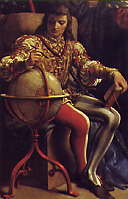Facts About Erdapfel
The Erdapfel, created by Martin Behaim between 1490 and 1492, holds the distinction of being the oldest surviving terrestrial globe. This remarkable artifact is constructed from a laminated linen sphere, split into two halves, reinforced with wood, and embellished with a map painted by Georg Glockendon. The map itself was drawn on paper and then adhered to a layer of parchment wrapped around the globe.
Notably, the Erdapfel does not feature the Americas, as Christopher Columbus had not yet returned to Spain when it was made. Instead, the globe displays an enlarged Eurasian continent, a vast empty ocean lying between Europe and Asia, and includes mythical locations such as Saint Brendan's Island and a misplaced Cipangu (Japan).
The name "Erdapfel" may be connected to the Reichsapfel ("Imperial Apple"), which was also kept in Nuremberg alongside the Imperial Regalia. It is important to note that the name has no relation to the modern German and Austrian term "Erdapfel" meaning "potato" as potatoes had yet to be introduced to Europe from the Americas at that time.
Originally, the Erdapfel was displayed in the Nuremberg town hall. It later became part of the Behaim family collection. In 1907, it found a new home at the Germanic Museum in Nuremberg. In 1992, the globe was temporarily relocated to the Vienna University of Technology for detailed study as part of the Behaim Digital Globe Project. Another digitalization effort was initiated by the German National Museum in 2011.
Terrestrial globes have a long history, with The Globe of Crates being an early example. However, no ancient terrestrial globes have survived to the present day, not even in fragments. A rare exception in the realm of ancient globes is the celestial Farnese Atlas from the second century AD.

 Poland
Poland